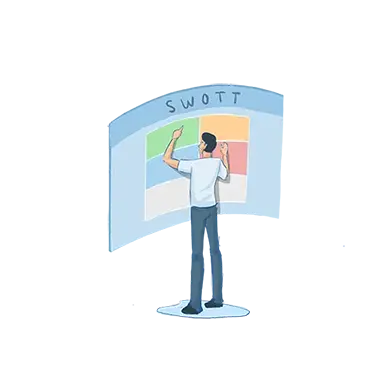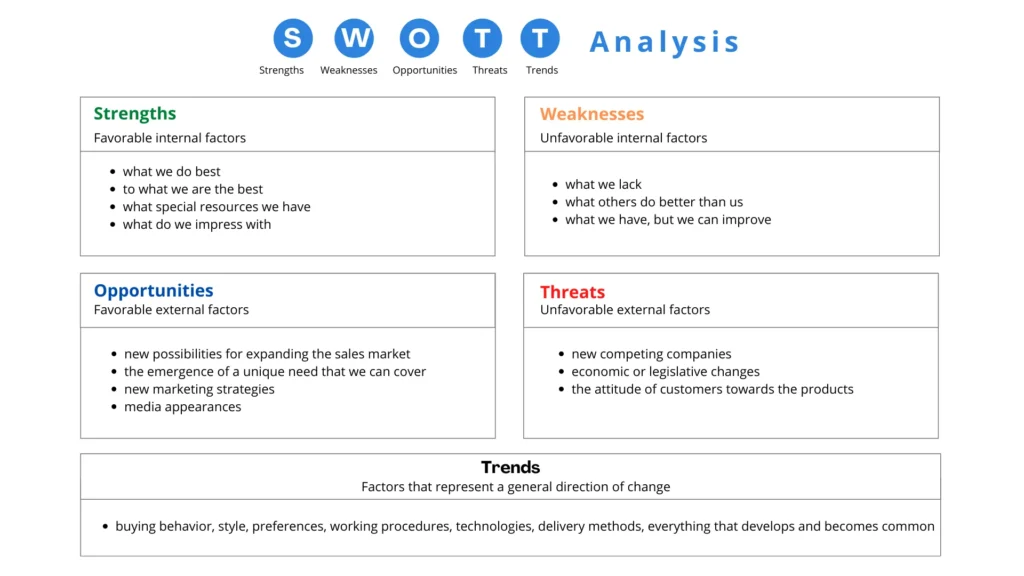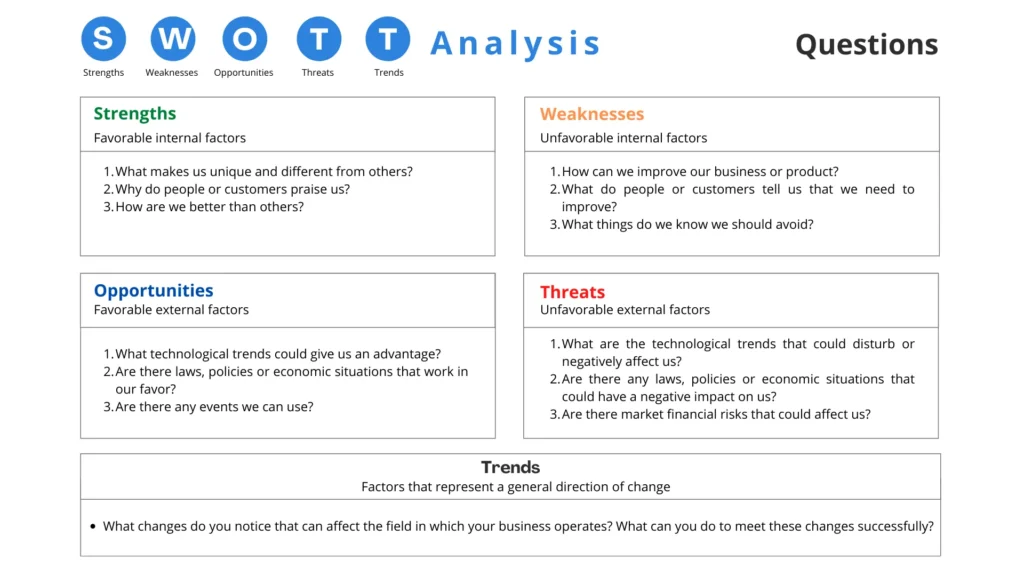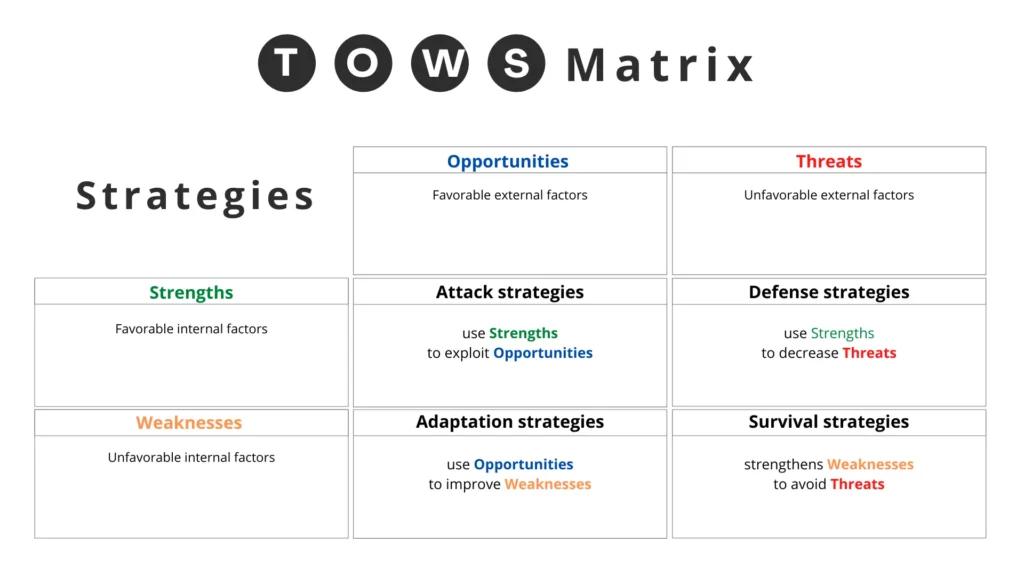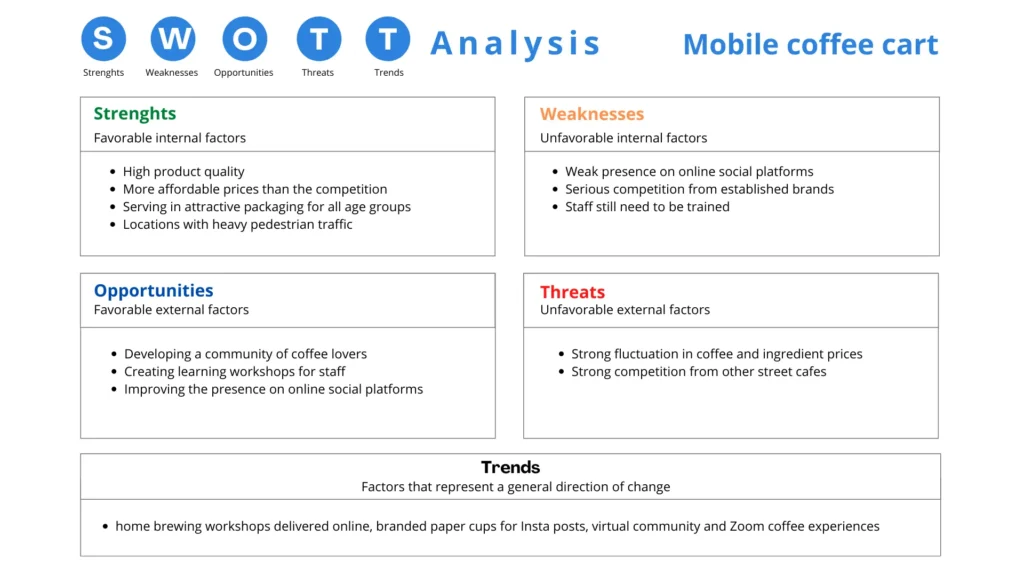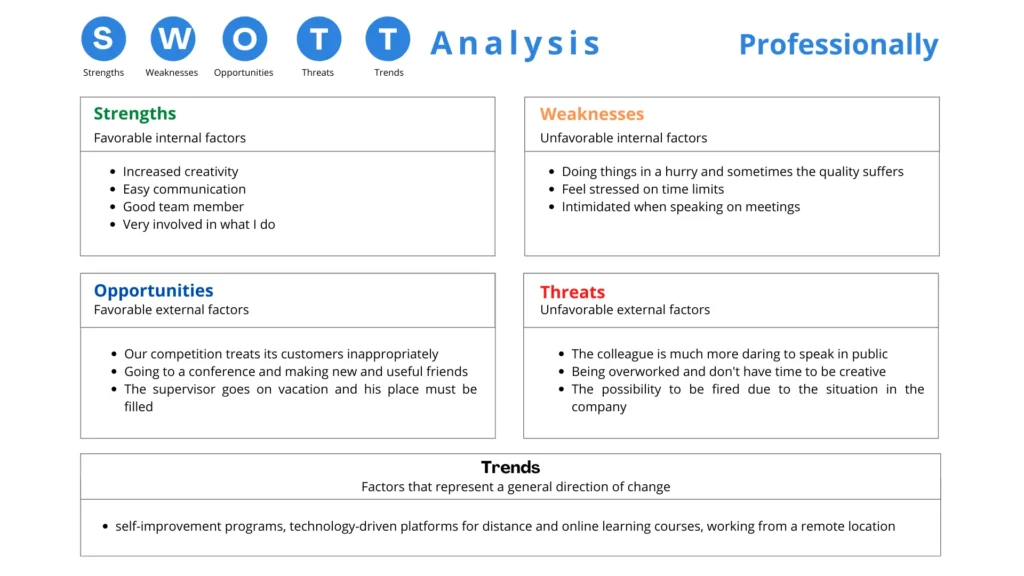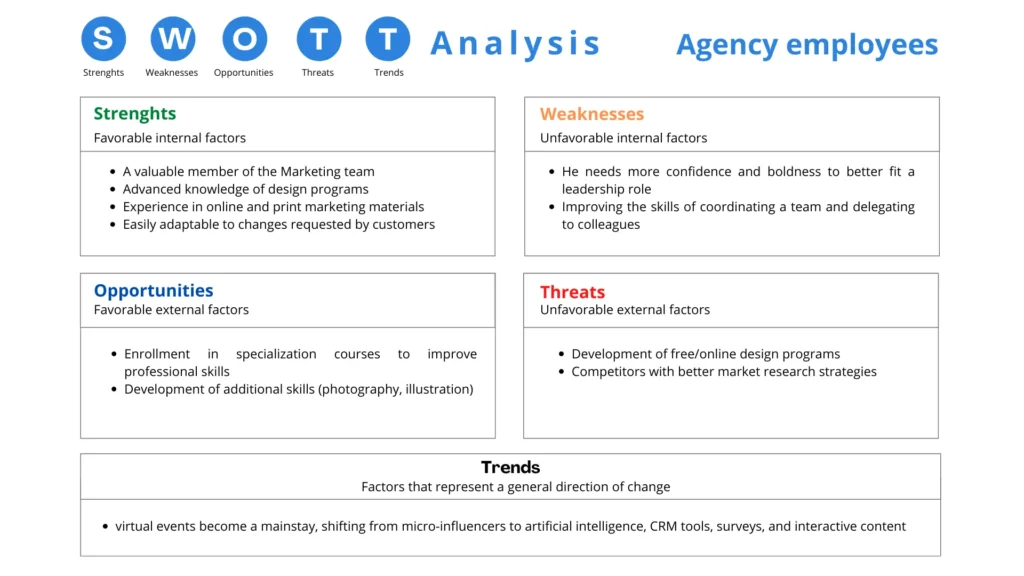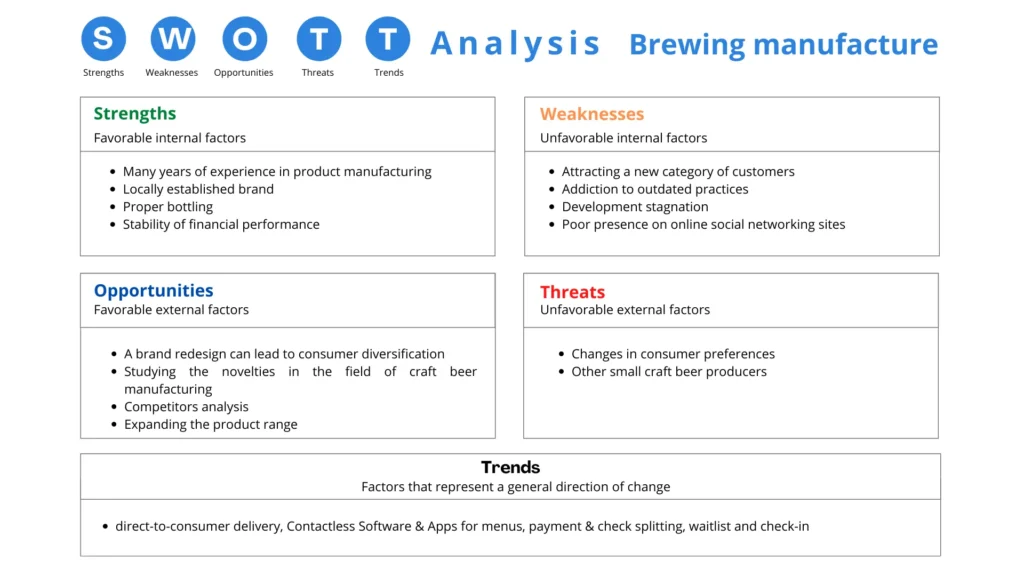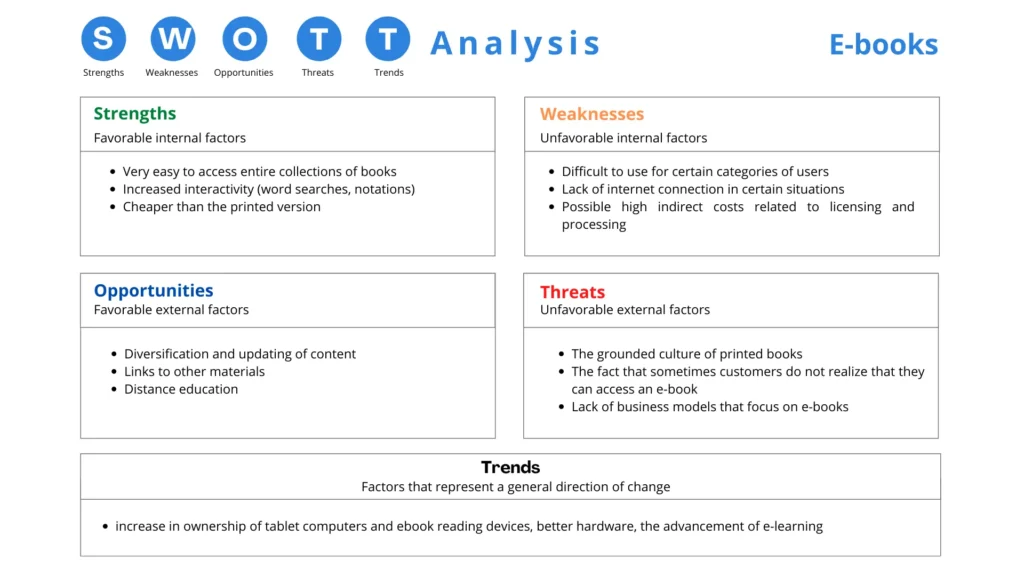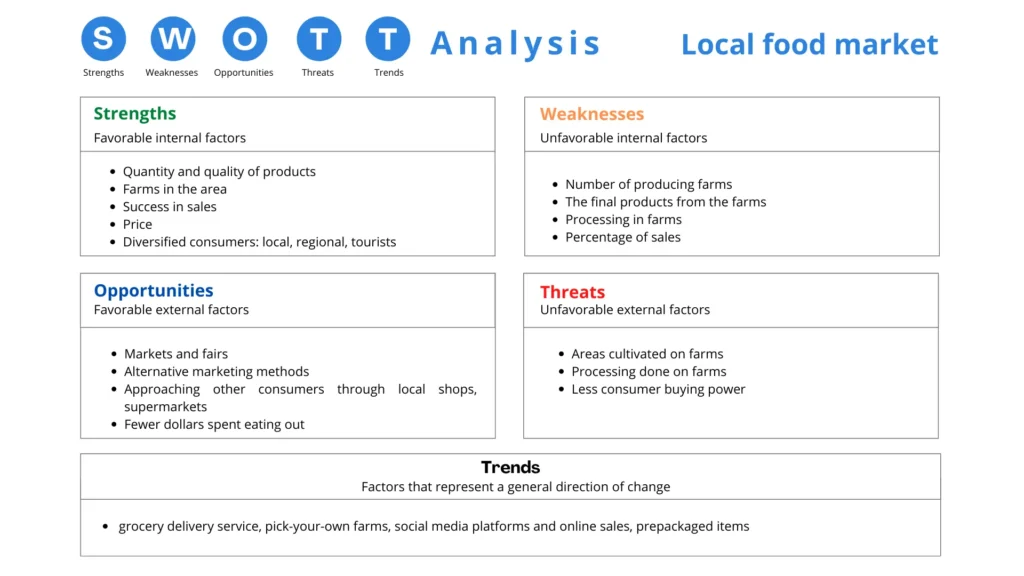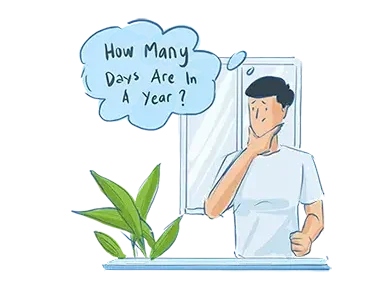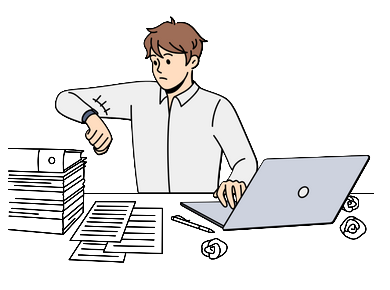A SWOTT analysis is how we can create an overview of an entity. It is beneficial for making informed decisions and formulating strategies. We can apply it to a company, product, place, industry, project, or person.
Through the SWOTT analysis, we identify the internal and external factors favorable and unfavorable for achieving the goal we set.
The SWOTT analysis is the brainstorming and planning tool to help an entrepreneur evaluate an idea or project or formulate a business plan.
What does SWOTT analysis mean?
The term “SWOTT” is an acronym created from Strengths, Weaknesses, Opportunities, Threats, and Trends.
Therefore, “SWOTT analysis” refers to discovering and balancing all these factors that characterize and influence an entity.
| S | W | O | T | T |
|---|---|---|---|---|
| Strengths | Weaknesses | Opportunities | Threats | Trends |
SWOT analysis (with only one “T”)
Note that there is also the analysis and the acronym SWOT. The second “T” (from the word Trends) does not appear in this case. Therefore, Trends that may influence the analyzed entity will not be considered in the SWOT analysis.
| S | W | O | T |
|---|---|---|---|
| Strengths | Weaknesses | Opportunities | Threats |
| Internal favorable factors | Internal unfavorable factors | External favorable factors | External unfavorable factors |
What is a SWOTT analysis?
A SWOTT analysis is a handy managerial tool for collecting and organizing information to understand the organization’s strategic position.
This analysis provides a qualitative comparison of internal and external factors that can influence the achievement of a particular objective in our field of interest. Among others, it can be about:
- launching new products on the market
- the status and development prospects of our small business
- evaluation and analysis of the evolution of projects of any type (investments, marketing, design)
- analyzing our situation at work
Once we have completed the analysis, we can make decisions and build strategies, which will lead to the fulfillment of the goal we set. For this, we will have to:
- strengthen favorable internal factors and build on them – (S) Strengths
- strengthen unfavorable internal factors or eliminate them – (W) Weaknesses
- take advantage of good external factors – (O) Opportunities
- avoid or even remove negative external factors – (T) Threats
- see how we can keep up with the changes that lie ahead – (T) Trends
A significant thing to mention and remember is that the SWOTT analysis does not quantify the factors that affect the analyzed entity. Therefore, no unit of measurement can be applied to put the discovered elements in a particular order. Still, we can use the TOWS matrix to make various correlations between the influencing factors.
To find the best option, among other strategic alternatives available, we can use the SWOTT analysis with any multi-attribute decision-making technique like TOPSIS (Technique for Order Preference by Similarity to Ideal Solution).
How to do a SWOTT analysis
To perform a SWOTT analysis, we need adequately labeled sections: Strengths, Weaknesses, Opportunities, Threats, and Trends.
We will notice that we can identify different factors that can influence us in reaching the goal we set on the two columns and two lines. Thus, on the two vertical columns, we have:
- Favorable factors
- Unfavorable factors
And on the two horizontal lines, we will identify:
- Internal factors
This category of factors usually includes elements within the organization. Therefore, we can take the information from all active areas of the company such as Production, Marketing, Organization, Personnel, Finance, or Research and Development. - External factors
This category of factors is most often related to the competition. It also includes the following:- the economic-social-political environment in which we operate
- evolution of the market
- behavioral aspects of customers
Trends are elements that show the general direction of change. For this reason, Trends are elements that can influence both internal and external factors and favorable and unfavorable ones.
What information do we process in a SWOTT analysis?
Taking into account these characteristics, we will fill in the fields with the corresponding information, namely:
Strengths
We note the internal factors that are favorable to us. We will include what our company does well and the qualities that differentiate us from our competitors. We can also write that we have qualified personnel or elements such as intellectual property, sources of funding, or technologies that we own.
Weaknesses
We will include unfavorable internal factors. Here, we can note the resources that we lack, things that our competitors do better than we do, and, in principle, everything that is weaker and that we want to improve. Lack of promotion or reduced funding also falls into this category.
Opportunities
We will note the external factors that may be favorable to us. Examples in this category can be the fact that a new need has just emerged for our products, possible appearances in the press, or the small number of competing companies in the area. We can also consider the increase in consumer revenues or the decrease in prices for specific technologies.
Threats
We write the external factors that are unfavorable to us. From the appearance on the market of new competing companies to legislative changes or customer tastes, we should point out, in this field, anything we consider to be a Threat to the goal we have set. Of course, the economic downturn is also a factor in this.
Trends
Here, list internal, external, favorable, and unfavorable factors showing us the prevailing Trend in style or preferences, the technological development direction, and the general movement from an economic, social, and political point of view.
Questions that help us identify the factors to be analyzed
To determine the elements we need to note for each section, we can use a few questions:
Strengths
- What makes us unique and different from others?
- Why do people or customers praise us?
- How are we better than others?
- What is unique about our offer?
- What do we have that competing companies do not have?
Weaknesses
- How can we improve our business or product?
- What do people or customers tell us that we need to improve?
- What things do we know we should avoid?
- What is the most common complaint from customers?
- What do competing companies have that we don’t have?
Opportunities
- What technological trends could give us an advantage?
- Are there laws, policies, or economic situations that work in our favor?
- Are there any events we can use?
Threats
- What are the technological trends that could disturb or negatively affect us?
- Are there any laws, policies, or economic situations that could harm us?
- Are there market financial risks that could affect us?
Trends
- What are the changes from a socio-economic-political point of view?
- In what sense are technologies developing?
- What are the shifts in customer behavior?
Strategies derived from a SWOT analysis
As we have seen, this analysis provides an overview of the analyzed entity, not the solutions. To draw conclusions and take the appropriate measures, we will have to do something with this information to process it.
TOWS matrix
The TOWS matrix is the one that allows us to associate the elements discovered in the SWOT analysis to find effective strategies.
We can make different correlations among the four types of factors analyzed, and four types of strategies will be obtained that will help us:
- take advantage of our Strengths and improve them
- correct the Weaknesses and overcome them
- take advantage of Opportunities and capitalize on them
- keep Threats under control and neutralize them
By applying the TOWS matrix, we will obtain four strategies that we can use to achieve our goals concerning the analyzed entity.
Remember, when brainstorming to formulate strategies, we must keep Trends in mind. These are the ones that will allow the business to take advantage of all potential aspects of development.
1. Attack strategy
Strength – Opportunity
The correlations between these two types of analyzed factors will help us identify which of the company’s Strengths we can use to make the most of the Opportunities discovered.
For example, if we know that our product, homemade sugar-free chocolate, is very successful on the market and that a fair is coming soon, we can promote it intensively in the run-up to this fair.
| Attack strategy | |
|---|---|
| Strength | The product: sugar-free homemade chocolate. |
| Opportunity | The Christmas fair. |
| Strategy | Advertising and intensive promotions for this product on online social media, in the period preceding the organization of the fair. |
2. Defense strategy
Strength – Threat
The correlations between these two types of factors in a SWOT analysis help us determine whether we can use the company’s Strengths to minimize and perhaps even remove identified Threats.
Let’s take into account the same Strength, namely, sugar-free chocolate. As a Threat, we assume that after the winter holidays, the demand decreases. Therefore, we can create a strategy to reduce the product’s price or include it in promotional packages.
| Defense strategy | |
|---|---|
| Strength | The product: sugar-free homemade chocolate. |
| Threat | Decrease in demand after the winter holidays. |
| Strategy | Launching offers that include lowering prices and creating promotional packages. |
3. Adaptation strategy
Weakness – Opportunity
By correlating these two types of factors, we have the chance to see which of our Weaknesses can be adapted or changed to help us take advantage of the identified Opportunities.
Let’s consider the product of dark chocolate as a Weakness, for which we do not have very high demand, and as an Opportunity, the same Christmas fair from the previous example. As a strategy, we have the chance to adapt the product to fit better the Opportunity considered.
| Adaptation strategy | |
|---|---|
| Weakness | The product is dark chocolate. |
| Opportunity | The Christmas fair. |
| Strategy | We create dark chocolate with ripe apple cream and cinnamon. |
4. Survival strategy
Weakness – Threat
The correlation between these two types of factors can help us find solutions to Weaknesses to avoid the Threats identified in the SWOTT analysis.
Continuing the series of examples above, let’s consider as a Weakness the fact that we no longer have personalized packaging for the Christmas fair and as a Threat that all the other stands will have. The strategy we can adopt is to tie the boxes of candies with ribbons to which we attach presentation cards.
| Survival strategy | |
|---|---|
| Weakness | Non-personalized packaging. |
| Threat | Competing stands at the Christmas fair. |
| Strategy | Tie a ribbon to each box with a presentation card. |
Gym
As a result of the SWOTT analysis of a gym, we find the following:
- Among the Strengths (favorable internal factors) is that customers are delighted with the services offered, and there is a high and constant number of enrollments in the programs offered. Also, the location is excellent for such an activity, and the prices are affordable compared to the competition.
- The Weaknesses (unfavorable internal factors) include marketing, which can certainly improve, and advertising. However, it also consists of the lack of adjacent services requested by customers, namely, massage, swimming, and a solarium.
- Opportunities (unfavorable internal factors) can be supplementing services with a team of nutritionists, creating a bar with healthy drinks, and developing a marketing team.
- The Threats (unfavorable external factors) are the other gym in the area, the nearby cafes, and the fact that more customers prefer to run in the park.
- The Trends are the technological development that allows for a better connection and user experience, intensive development of home fitness, and the appearance of digital workouts.
Several strategies can be formulated by correlating the analyzed factors. Below, we present some examples, mentioning that we can make many other correlations between the factors influencing this type of business. Therefore, we can find many different strategies.
| Attack strategy which of the company’s Strengths can be used to make the most of the Opportunities discovered | |
| Strength | Good reputation among customers. |
| Opportunity | Hiring a team of nutritionists. |
| Strategy | Many clients will call on the services of nutritionists, which will help consolidate this Strength of the gym. |
| Defense strategy which of the company’s Strengths can be used to minimize and even remove identified Threats | |
| Strength | A large number of registrations. |
| Threat | Fierce competition from the other gyms. |
| Strategy | Creating loyalty programs for all those enrolled. |
| Adaptation strategy which of our Weaknesses can be adapted/changed to help us take advantage of the Opportunities identified | |
| Weakness | Advertising can be better. |
| Opportunity | Development of the marketing team. |
| Strategy | A specialized team will remarkably improve the entire marketing process, implicitly and advertising. |
| Survival strategy what solutions do we have for our Weaknesses so that we can avoid Threats? | |
| Weakness | Lack of adjacent services (massage, swimming). |
| Threat | Many prefer to run in the park. |
| Strategy | A massage and a natural juice when ending their workout may sound appealing to those running in the park. |
According to the Trends
- The client should talk online with the nutritionist, and the evaluation and counseling sessions should take place by videoconference;
- Loyalty programs should be accessible online;
- The gym should have new and high-performance devices.
Mobile coffee cart
A SWOTT analysis of a mobile coffee cart can provide us with the following information:
- Strengths are the fact that prices are more affordable than those of the competition, the quality of the products is high, the activity locations are excellent, and all customers love the packaging.
- Weaknesses are related to the presence on online social platforms, the fact that well-known brands comprise serious competition, and should train all their new and existing employees.
- Opportunities stood out as the development of a community of coffee lovers, the creation of workshops in which the staff is specialized, and the improvement of the online presence.
- The Treats are related to the strong fluctuation of ingredients and the competition made by other mobile coffee carts.
- The Trends are the need for online workshops, branded cups, encouraging their use in online posts, and creating and consolidating virtual communities.
Some of the Strategies that may appear after analyzing and correlating these factors are the following:
| Attack strategy which of the company’s Strengths can be used to make the most of the Opportunities discovered | |
| Strength | Serving in attractive packaging for all age groups. |
| Opportunity | Developing a community of coffee lovers. |
| Strategy | Customers have the opportunity to propose and choose their favorite recipe; the most voted will be included in a promotional package one day next week. |
| Defense strategy which of the company’s Strengths can be used to minimize and even remove identified Threats | |
| Strength | More affordable prices than the competition. |
| Threat | Strong fluctuation in coffee and ingredient prices. |
| Strategy | Keeping prices below the level of competition, even if sometimes that means a temporary reduction in profit. |
| Adaptation strategy which of our Weaknesses can be adapted/changed to help us take advantage of the Opportunities identified | |
| Weakness | Staff still need to be trained. |
| Opportunity | Creating learning workshops for staff. |
| Strategy | Newly hired staff will initially participate in introductory courses; later, all will participate in training workshops. |
| Survival strategy what solutions do we have for our Weaknesses so that we can avoid Threats? | |
| Weakness | Weak presence on online social platforms. |
| Threat | Intense competition from other street cafes. |
| Strategy | Intensive interaction and launching online loyalty offers on social platforms. |
According to the Trends
- The voting in the Attack Strategy can take place online, live.
- Introductory courses and subsequent workshops will take place on an online platform and can be viewed by customers.
Personally, from a professional point of view
In a personal SWOTT analysis, we identify the following factors that can influence our professional activity:
We take into account that we have identified the following:
- For Strengths, an increased level of creativity and the fact that we communicate efficiently, are excellent team members and get seriously involved in what we do.
- Our Weaknesses are that we hurry and are not attentive to details, that we are intimidated by public speaking, and that when we are upset, we stress easily.
- The Opportunities include the fact that soon the supervisor will go on vacation, so for a while, we will have the chance to experience new things and participate in a conference. Thus, we will expand our peers.
- The Threats are the more daring colleague, the fact that we feel tired, and the possibility of being fired.
- Also, we noticed as Trends the self-improvement programs, the online learning platforms, and working from home or a remote location.
Let’s see some of the correlations we can make in this situation to use the Strengths to take advantage of Opportunities, get rid of Threats, improve the Weaknesses to avoid Threats, and benefit more from Opportunities.
| Attack strategy which of ours Strengths can be used to make the most of the Opportunities discovered | |
| Strength | Good team member. |
| Opportunity | The supervisor is going on vacation and I will take his place for a while. I will learn new things. |
| Strategy | I will benefit from the support of my teammates for the successful accomplishment of this task. |
| Defense strategy which of our Strengths can be used to minimize and even remove identified Threats | |
| Strength | Increased creativity. |
| Threat | I’m overworked, and I don’t have time to be creative. |
| Strategy | Better planning will help me have more time. |
| Adaptation strategy which of our Weaknesses can be adapted/changed to help us take advantage of the Opportunities identified | |
| Weakness | I get intimidated when I have to present my point of view in the meeting. |
| Opportunity | The supervisor is going on vacation and I will take his place for a while. I will learn new things. |
| Strategy | I will participate in a course to improve my public speaking techniques. |
| Survival strategy what solutions do we have for our Weaknesses so that we can avoid Threats? | |
| Weakness | I get intimidated when I have to present my point of view in the meeting. |
| Threat | My colleague is much more daring with regard to speaking in public. |
| Strategy | The same course on public speaking will help me in this regard as well. |
According to the Trends
- Take some online self-improvement courses
- Use a time management solution to track time
- Use an interactive calendar for better and more efficient planning.
Other examples of SWOTT analysis
Depending on the information provided by the SWOTT analysis, we can set the objectives we want to achieve and formulate strategies.
However, keep in mind that one of the most important things we find out after performing a SWOTT analysis is the current situation of the analyzed entity.
This is the starting point for anything else we want to do next.
The SWOTT analysis provides a clear overview of what must be addressed to keep the company growing, prosperous, and competitive.
